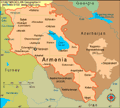Geography
Armenia is located in the southern Caucasus and is the smallest of the former Soviet republics. It is bounded by Georgia on the north, Azerbaijan on the east, Iran on the south, and Turkey on the west. Contemporary Armenia is a fraction of the size of ancient Armenia. A land of rugged mountains and extinct volcanoes, its highest point is Mount Aragats, 13,435 ft (4,095 m).
Government
Republic.
History
One of the world's oldest civilizations, Armenia once included Mount Ararat, which biblical tradition identifies as the mountain that Noah's ark rested on after the flood. It was the first country in the world to officially embrace Christianity as its religion (c. A.D. 300).
In the 6th century B.C., Armenians settled in the kingdom of Urartu (the Assyrian name for Ararat), which was in decline. Under Tigrane the Great (fl. 95–55 B.C.) the Armenian empire reached its height and became one of the most powerful in Asia, stretching from the Caspian to the Mediterranean seas. Throughout most of its long history, however, Armenia has been invaded by a succession of empires. Under constant threat of domination by foreign forces, Armenians became both cosmopolitan as well as fierce protectors of their culture and tradition.
Over the centuries Armenia was conquered by Greeks, Romans, Persians, Byzantines, Mongols, Arabs, Ottoman Turks, and Russians. From the 16th century through World War I, major portions of Armenia were controlled by their most brutal invader, the Ottoman Turks, under whom the Armenians experienced discrimination, religious persecution, heavy taxation, and armed attacks. In response to Armenian nationalist stirrings, the Turks massacred thousands of Armenians in 1894 and 1896. The most horrific massacre took place in April 1915 during World War I, when the Turks ordered the deportation of the Armenian population to the deserts of Syria and Mesopotamia. According to the majority of historians, between 600,000 and 1.5 million Armenians were murdered or died of starvation. The Armenian massacre is considered the first genocide of the 20th century. Turkey denies that a genocide took place and claims that a much smaller number died in a civil war.
Striving for Independence
After the Turkish defeat in World War I, the independent Republic of Armenia was established on May 28, 1918, but survived only until Nov. 29, 1920, when it was annexed by the Soviet army. On March 12, 1922, the Soviets joined Georgia, Armenia, and Azerbaijan to form the Transcaucasian Soviet Socialist Republic, which became part of the USSR. In 1936, after a reorganization, Armenia became a separate constituent republic of the USSR. Armenia declared its independence from the collapsing Soviet Union on Sept. 23, 1991.
In 1988, Armenia became involved in a territorial dispute with Azerbaijan over the enclave of Nagorno-Karabakh. The majority of the enclave consisted of Armenian Christians who wanted to secede from Azerbaijan and either become part of Armenia or gain full independence. War ensued between Armenia and Azerbaijan over the region from 1992–1994, resulting in 30,000 casualties. Armenia effectively controls the region today, although no formal resolution exists.
An Armenian diaspora has existed throughout the nation's history, and Armenian emigration has been particularly heavy since independence from the Soviet Union. An estimated 60% of the total 8 million Armenians worldwide live outside the country, with 1 million each in the United States and Russia. Other significant Armenian communities are located in Georgia, France, Iran, Lebanon, Syria, Argentina, and Canada.
The Death of Markarian Leads to Political Unrest
Prime Minister Andranik Markarian died suddenly in March 2007. He was replaced by Defense Minister Serzh Sarkisyan.
Sarkisyan won almost 53% of the vote and former president Levon Ter-Petrosyan took 21.5% in February 2008 presidential elections. Ter-Petrosyan, who was Armenia's first president after it gained independence in 1991, claimed the vote was rigged. Tens of thousands of his supporters took to the streets in Yerevan to protest the election. A 20-day state of emergency was declared on March 1 when the protests turned violent and eight people were killed. On March 22, the state of emergency ended and troops left the capital.
On April 9, 2008, Serzh Sarkisyan was sworn in as president and named Tigran Sarkisyan (no relation) as prime minister.
Rapprochement With Turkey Only Temporary
After nearly 100 years of hostility between Turkey and Armenia over the murder of between 600,000 and 1.5 million Armenians at the hands of Ottoman Turks during World War I, the two countries agreed in Oct. 2009 to establish diplomatic relations and reopen the border between them. However, both parliaments had to approve the agreement, which didn't happen, and the deal was never implemented. In February 2015 Armenian president Serzh Sarkisyan withdrew the agreement from parliament, citing Turkey's lack of commitment to the agreement.
Continuing trouble on the border between Armenia and Azerbaijan resulted in the deaths of at least three Armenian and five Azerbaijani soldiers in early June 2012. The eruption of violence coincided with Secretary of State Hillary Clinton's visit to the region; she made a statement imploring both sides to honor a ceasefire for the area that was first contested in the 1990s, Nagorno-Karabakh.
Safarov Pardon Increases Tension with Azerbaijan and Hungary
On August 31, 2012, Armenia ended diplomatic relations with Hungary over the return of Ramil Safarov to Azerbaijan. Safarov was convicted of killing Armenian Lieutenant Gurgen Margaryan in 2004 in Hungary. The Hungarian government released Safarov to Azerbaijan on the assumption that he would serve at least 25 years of his life sentence. Upon his arrival in Azerbaijan, Safarov was pardoned. Once news of the pardon hit, protestors in Armenia burned Hungarian flags and threw eggs at the Hungarian Embassy. Demonstrations were also held in Budapest.
Safarov was welcomed back to Azerbaijan. A lieutenant at the time of the murder, Safarov was promoted to rank of major, given eight years of back pay, and treated as a national hero in September 2012. His pardon and warm welcome threatened to break up the peace process between Azerbaijan and Armenia, a process that has kept the two countries from backsliding into violent feud over the disputed Nagorno-Karabakh territory.
Sarkisyan Easily Wins Second Term
In February 2013, Serzh Sarkisyan was re-elected to a second five-year term as president. Preliminary returns showed that Sarkisyan received 59 percent of the vote, enough of a majority to avoid a runoff. Raffi Hovanessian, a former foreign minister, came in second, far behind at 37 percent.
Seen as a stable leader who had made economic improvements during his first term, Sarkisyan had been favored to win for months. The election wasn't without conflict. Paruir A. Airikyan, another candidate for president and former Soviet dissident, was shot in late January 2013, as the election approached. Authorities ruled it as an assassination attempt. Airikyan threatened to delay the election by using a provision in Armenia's constitution due to his injury, but decided against it.
Pope Francis Creates Firestorm Over Genocide Comment
In April 2015, Pope Francis called the 1915 murder of between 600,000 and 1.5 million Armenians at the hands of Ottoman Turks during World War I the first genocide of the 20th century. He made the comment at a mass commemorating the 100th anniversary of the massacre. Turkey responded by withdrawing its ambassador to the Vatican.
See also Encyclopedia: Armenia .
U.S. State Dept. Country Notes: Armenia
Ministry of Statistics www.armstat.am/ .










